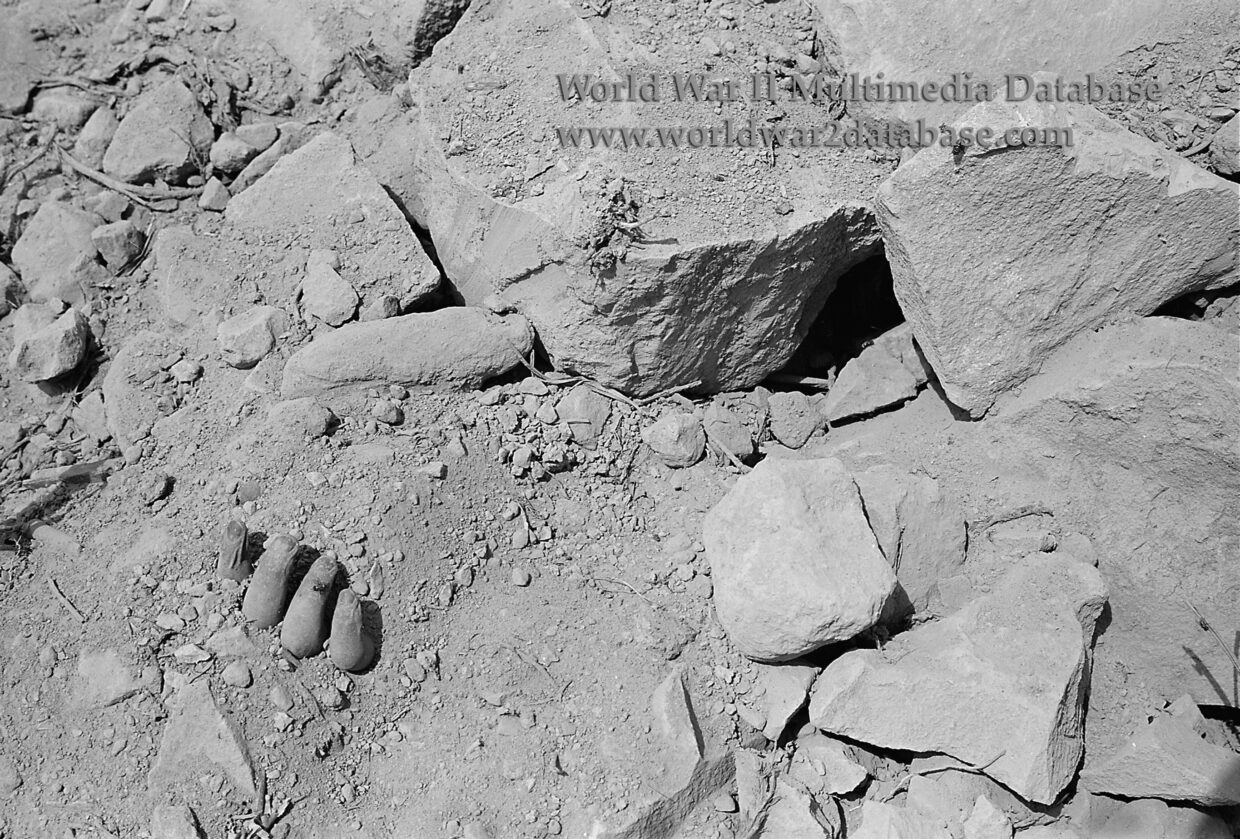| The hand of a Japanese soldier killed by a bomb blast is seen in the rubble which covered the island. Note the fly on his finger. One of the most controversial elements of the Iwo Jima invasion was the extent of the pre-landing bombardment. Preliminary air bombardment of Iwo Jima was delivered by heavy bombers operating from the Marianas bases. B-24 Liberators bombed for 70 consecutive days, releasing at 18000-20000 feet (5500-6100 meters) usually against antiaircraft fire. Once or twice a group of B-29 Superfortresses assisted. The prolonged aerial bombardment of Iwo Jima had no effect in the reduction of well prepared and heavily fortified defensive installations. The Japanese estimated that 40 percent of the bombs missed the island completely. Direct air support operations against Iwo Jima began on D-3 (February 16, 1945) with the arrival of Task Forces 52, consisting of nine to eleven escort carriers. Marine commanders had requested ten days of preliminary shelling. Fifth Fleet commander United States Navy Admiral Raymond A. Spruance did not permit such a long bombardment, believing incorrectly that months of constant attacks had degraded enemy defenses. He allowed only three days for the task, and denied the Marines‘ pleas for more. Task Force 54, consisting of six battleships (Arkansas (BB-33), New York (BB-34), Texas (BB-35), Nevada (BB-36), Idaho (BB-42) and Tennessee (BB-43)), five cruisers (Pensacola (CA-24), Salt Lake City (CA-24), Chester (CA-27), Tuscaloosa (CA-37) and Vicksburg (CL-87)) and many destroyers participated. Japanese efforts to return fire pointed out the location of previously concealed pillboxes and other defenses. 700 fortified positions had been identified, and all could not be dealt with in the remaining time. On February 18 fire was concentrated on the landing beach areas and the adjacent heights. On D-Day three more battleships (North Carolina (BB-55), Washington (BB-56) and West Virginia (BB-48)) arrived; three additional cruisers (Indianapolis (CA-36), Santa Fe (CL-60) and Biloxi(CL-80)) joined to the battle. The southern half of the island received a rain of fire. Many targets were hit but the enemy garrison was very well sheltered in deep caves and bunkers. Twenty minutes after Fourth and Fifth Marine Divisions came ashore, these soon revealed themselves in a deadly barrage of artillery, mortars and automatic weapons fire. Inland from the beaches, on Mount Suribachi to the south, and in the rugged terrain to the north, even more tough defenses survived. These would have to be overcome by close-in infantry combat, not bombardment. | |
| Image Filename | wwii1182.jpg |
| Image Size | 1.89 MB |
| Image Dimensions | 2730 x 1848 |
| Photographer | Steichen, Edward |
| Photographer Title | Lieutenant Commander |
| Caption Author | Jason McDonald |
| Date Photographed | March 01, 1945 |
| Location | Iwo Jima |
| City | Iwo Jima |
| State or Province | Bonins |
| Country | Japan |
| Archive | National Archives and Records Administration |
| Record Number | |
| Status | Caption ©2007, ©2024 MFA Productions LLC Image in the Public Domain |

Author of the World War II Multimedia Database

